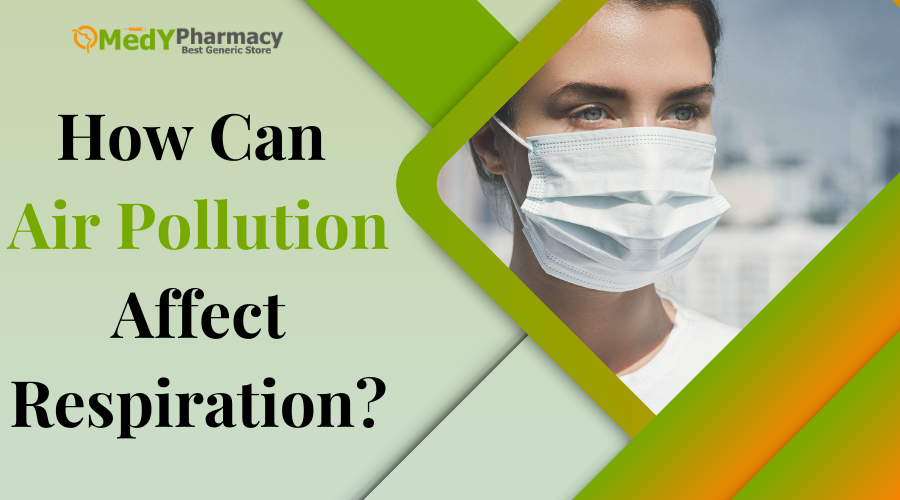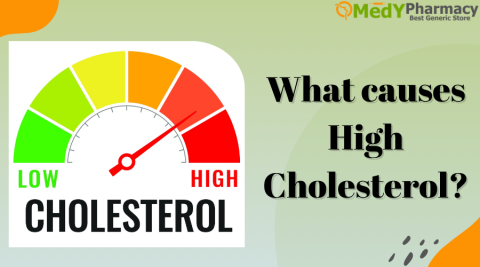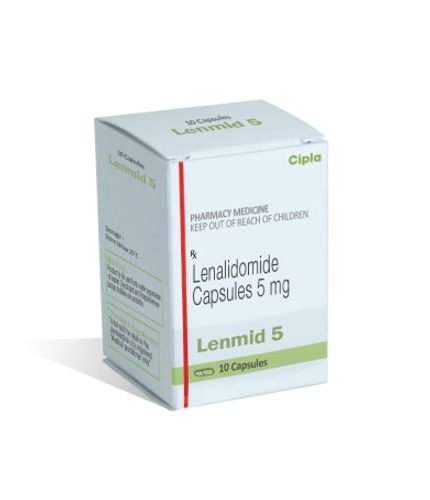Introduction:
Can you survive without breathing? I suppose you can’t even imagine it? Life without breathing is unthinkable to everybody on the planet. It is expected that you will breathe in clean air, which will improve your health. In your contaminated city, is it feasible to breathe air pollution-free of toxins? You can’t do that, can you?
As you leave your home, pollution surrounds you. Factory chimneys release harmful substances, which are transformed into harmful gases and discharged into the atmosphere. Factory waste and hazardous chemicals from automobiles are also sources of air pollution.
The haze fills your indoor space and conceals the beautiful sky. Inhaling this contaminated air has an impact on your health. Your eyes may not be able to detect the contaminated air.
However, your respiratory system and respiration are greatly impacted by this polluted air. Do you realize that there is a direct connection between air pollution and your lungs?
You’re unaware of the potential harm this might do to your health. Asthma is one of the respiratory diseases brought on by contaminated air. Continue reading to learn more about this subject.
Lung infections, respiratory problems, and worsened asthma can result from brief contact. On the other hand, prolonged exposure is linked to long-term conditions including lung cancer, stroke, cardiovascular disease, and even neurological issues.
Children, the elderly, and people with pre-existing medical disorders are among the vulnerable groups that are most in danger.
What Is Air Pollution?
There will be pollutants in the air that progressively contaminate the lungs. Polluted air will eventually begin to harm different organs.
- Smoke
- Dust
- Mist
- Fumes
- Vapor
- Gas
- Odor
There are levels of these pollutants that might be detrimental to your health. The respiratory system allows poisonous air to enter your body. Numerous lung-related illnesses develop as a result of breathing in these pollutants.
When dangerous pollutants are present in the air, they can negatively impact the ecosystem, human health, and the climate. This is known as air pollution. Gases, particles, and biological molecules are examples of things that are released into the atmosphere as a result of human activity or natural processes.
- Heart disease
- Oxidative stress
- Brain issues
- Inflammation
Wide-ranging consequences may result from this, such as cancer, heart issues, and respiratory disorders. Because it increases the amount of greenhouse gases in the atmosphere, it can also contribute to climate change. This may also disrupt ecosystems, causing harm to waterways, forests, and agriculture.
If you have been diagnosed with lung allergies, using Medrol 16 mg may be quite beneficial.
How Can Air Pollution Occur?
Numerous natural and artificial mechanisms might cause this. In essence, it occurs when dangerous materials are dropped into the atmosphere, either directly or indirectly, degrading the quality of the air.
This is caused by the discharge of methane, ammonia, and pesticides by farming operations. Carbon held in trees may also be released into the atmosphere when large-scale deforestation occurs for agricultural purposes.
Whether garbage is burned outdoors or in incinerators, it releases a variety of contaminants, such as heavy metals and dioxins. Methane may be released from landfills as organic garbage breaks down.
Particulate particles, carbon dioxide, smoke, and other pollutants are released into the atmosphere by both natural and man-made wildfires.
Particularly in arid locations, wind may carry dust and other particulate matter from arid or desolate places, causing air pollution.
Sometimes, especially in metropolitan or valley regions, a layer of warmer air can trap colder air underneath it, preventing pollution from ascending and spreading. Higher levels of pollutants like smog and particulate matter are the result of this.
Wind can transport pollutants from one area to another. For instance, pollutants transported from a bustling industrial centre to a neighbouring rural location may impact air quality.
Typical Reasons for Air Pollution
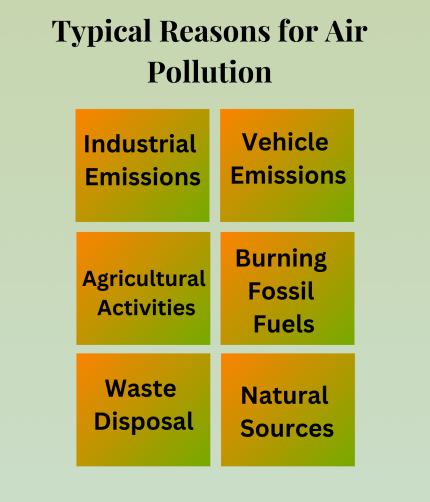
- Industrial Emissions
The term “industrial emissions” describes the pollutants that are discharged into the atmosphere as a result of several industrial processes. A major contributor to air pollution, industrial emissions also cause smog, acid rain, respiratory disorders, and climate change, among other environmental and health concerns.
These gases are created when combustion occurs at high temperatures, such as in industrial boilers, power plants, and automobiles. Acid rain and smog are both caused by nitrogen oxides.
Released by businesses such as those that produce fertilizer and raise cattle. Ammonia may create fine particulate matter in the atmosphere by reacting with other pollutants.
Despite being mostly phased out, CFCs, which are strong greenhouse gases that contribute to ozone depletion, are still released by some industrial processes.
- Vehicle Emissions
A colorless and odorless gas, carbon monoxide is created when fuel burns incompletely. It can be detrimental to human health by decreasing the quantity of oxygen carried by the blood, which can result in symptoms including headaches, lightheadedness, and in severe situations, death.
Vehicle exhaust gases and fuel evaporation are the main sources of VOC emissions. One of the main ingredients of smog, ground-level ozone, is created when VOCs and nitrogen oxides combine in the presence of sunlight. It can make respiratory disorders worse.
Certain automobiles, especially those with outdated catalytic converters, may release traces of lead and other heavy metals, which may build up in the environment and be harmful to human health.
- Agricultural Activities
Particularly in dry or windy circumstances, activities like ploughing, harvesting, and soil tilling can release significant volumes of dust and particulate matter into the atmosphere. In addition to contributing to air pollution, these particles may cause respiratory problems.
Inadequate management of agriculture can result in soil erosion and the discharge of particulate matter into the atmosphere. Especially in dry areas, this might make the air quality worse.
Large volumes of carbon trapped in the soil as CO₂ can be released in some areas when peatlands are drained for agricultural growth, which exacerbates climate change.
- Burning Fossil Fuels
Fossil fuel combustion is still the primary energy source in much of the globe, although it has serious negative effects on the environment and human health. Emissions, particularly carbon dioxide, contribute significantly to climate change, and pollutants such as sulphur dioxide, nitrogen oxides, and particulate matter deteriorate air quality and are harmful to human health.
Increasing the energy efficiency of industry, transportation, and buildings can lessen the need to use fossil fuels. This covers the use of more energy-efficient appliances, improved insulation, electric cars, and energy-efficient industrial operations.
- Waste Disposal
Solid waste includes commonplace objects such as building detritus, food waste, packaging materials, and domestic rubbish. Usually, it is disposed of in recycling facilities or landfills.
Managing and getting rid of waste items that are no longer needed or useful is known as trash disposal. Waste management practices, especially when done incorrectly, can have a major influence on the environment, society, and human health. Poor waste management techniques can have negative health effects as well as contaminate the air, land, and water.
Sewage, industrial liquids, and wastewater that are disposed of after usage are all considered liquid waste. Before being discharged into water systems, this kind of trash frequently has to be treated to avoid contamination.
- Natural Sources
The term “natural sources of air pollution” describes contaminants released by natural processes and sources as opposed to human activity.
Particularly for sensitive populations, including children, the elderly, and those with underlying medical disorders, wildfire smoke can lead to respiratory and cardiovascular issues.
In addition to lowering visibility, it can help create ground-level ozone, which is bad for plants and people alike.
Even though it is a naturally occurring result of decomposition, methane plays a major role in global warming. Landfills, rice paddies, and wetlands all release pollutants that exacerbate the greenhouse effect.
Organ Systems Affected by Air Pollutant Exposure
Long-term exposure to air pollution also affects other organs. They are mentioned below.
- Throat
- Nose
- Heart
- Liver
- Kidney
- Gastrointestinal system
The respiratory system is undoubtedly affected the most by this. The lungs’ tissues are stopped by the air contaminants. You therefore suffer from lung inflammation.
You may suffer from respiratory conditions, including chronic obstructive pulmonary disease or lung cancer. To relieve asthma, use Medrol 8 mg after seeing your pulmonologist.
Breathing becomes more challenging when exposed to ozone, nitrogen dioxide, and particulate matter, particularly in susceptible groups such as youngsters, the elderly, and people with underlying respiratory diseases.
An elevated risk of hypertension and elevated blood pressure has been associated with prolonged exposure to nitrogen dioxide and ozone (O₃).
According to studies, particulate matter, in particular from air pollution, may have an impact on mental health by raising the likelihood of mood disorders, including sadness and anxiety.
Chronic air pollution exposure causes inflammatory reactions all over the body, which can lead to the onset of a number of illnesses, including autoimmune diseases, allergies, and long-term respiratory ailments.
What Effects Does Air Pollution Have on Our Health?
As the organs most exposed to the air we breathe, the lungs are unavoidably among those that suffer the greatest harm from pollution. Consequently, bronchitis, asthma, chronic respiratory conditions, and all other allergic illnesses are worsened by elevated pollution levels, making pollution especially harmful to those who suffer from respiratory disorders.
Pollution also makes it more difficult for the lungs to expel mucus, which makes illnesses like pneumonia more likely.
Pollution also affects the heart, another essential organ. Stress hormones and local inflammation are released on days with high air pollution, increasing our risk of myocardial infarction, stroke, arrhythmias, and sudden cardiac death.
Additionally, chronic inflammation hardens our arteries and speeds up the aging process, which makes it simpler for cholesterol to adhere to the arterial walls.
This might help to explain the correlation between air pollution and long-term cardiovascular diseases such as heart failure, angina pectoris, and hypertension.
Everyone who lives in an area with high pollution levels, from young children to elderly people, is at a higher risk of experiencing an accelerated loss of cognitive capacity. This has been related to dementia, poor school performance, and reduced concentration.
Lastly, this has been linked to reduced conception rates, eye discomfort, hair loss, and poor sperm quality. It also affects the cells in our bodies that replicate continuously.
How Does Inhaling Air Pollution Affect Us?
Some pollutants are caught by filtering processes, including the branching bronchi and the hair-like cilia in the nose when the incoming air passes through the airway from the nose to the lungs. Nevertheless, some pollutants can get past these barriers and into the pulmonary air sacs.
- Respiratory System
Because contaminants enter the lungs through the breath, the respiratory system is most immediately affected by air pollution inhalation. Certain pollutants can cause irritation and harm, which can result in several respiratory issues.
People who already have asthma may find it more difficult to breathe due to increased airway inflammation caused by pollution.
Chronic illnesses like emphysema and chronic bronchitis are included in COPD, which can be brought on by or made worse by prolonged exposure to air pollution. Lung function gradually deteriorates as a result of these disorders, making breathing more challenging.
May impair the body’s ability to fight off respiratory infections like bronchitis and pneumonia by weakening the immune system’s protection.
Long-term exposure to air pollution’s carcinogenic components, such as radon, formaldehyde, and benzene, can raise the risk of lung cancer.
- Cardiovascular System
Because air pollution contributes to the development of atherosclerosis, it raises the risk of heart attacks. Inflammation and oxidative stress brought on by pollutants might result in blood clot development and stop blood flow to the heart.
Because pollutants like PM2.5 and ozone may cause blood clots and raise blood pressure, which can harm brain blood vessels, they can raise the risk of stroke.
Chronic exposure to air pollutants, especially nitrogen dioxide (NO₂) and ozone, is linked to high blood pressure. An increased risk of abrupt cardiac events and mortality can result from aberrant heart rhythms, or arrhythmias, caused by air pollution, especially particulate matter (PM2.5).
- Nervous System
The nervous system is known to be susceptible to air pollution, and both brief and prolonged exposure can have negative neurological and cognitive impacts.
Neurodegenerative illnesses like Parkinson’s and Alzheimer’s may advance more quickly after prolonged exposure.
Developmental delays, learning difficulties, and a lower IQ are possible outcomes for kids exposed to high levels of air pollution, particularly ozone, PM2.5, and nitrogen dioxide. At crucial stages of development, these contaminants may disrupt brain function.
Because pollutants like PM2.5 and carbon monoxide (CO) reduce blood flow to the brain, they can affect brain function and increase the risk of stroke. This can result in a loss of cognitive and physical abilities.
More and more research suggests that air pollution may be connected to a higher prevalence of mood disorders, including anxiety and depression, especially in those who are exposed to poor air quality regularly.
- Immune System
The body is more vulnerable to diseases and illness when the immune system is weakened by breathing in polluted air. Pollutants that can cause inflammation in the body include nitrogen dioxide, ozone, and PM2.5.
Prolonged exposure to air pollution can weaken the immune system’s defenses against diseases and infections, especially respiratory conditions like the flu and pneumonia.
People who are exposed to air pollutants such as PM2.5, ozone, and sulfur dioxide (SO₂) are more susceptible to infections because they can damage lung cells and the respiratory tract’s natural defenses.
Long-term exposure to air pollution may raise the risk of autoimmune illnesses, in which the body’s cells are erroneously attacked by the immune system. In several studies, air pollution has been connected to diseases including multiple sclerosis, lupus, and rheumatoid arthritis.
- Reproductive System
Additionally, air pollution may influence fertility and pregnancy by affecting the reproductive system.
Male and female fertility can be decreased by exposure to pollutants including endocrine-disrupting chemicals (EDCs) and heavy metals. EDCs can interfere with reproductive organ function and change hormone production.
High levels of PM2.5, ozone, and nitrogen oxides (NOₓ) during pregnancy increase the risk of issues like miscarriage, low birth weight, and premature birth. Additionally, air pollution can harm fetal development, resulting in lung issues and developmental abnormalities in the offspring.
Worse fertility rates and worse sperm quality have been associated with male exposure to air pollution, namely PM2.5 and heavy metals.
- Integumentary System
Air pollution can also have negative impacts on the skin. Pollutants that can harm skin and hasten the aging process include particulate matter, ozone, and volatile organic compounds (VOCs).
Long-term exposure to pollutants, especially ozone (O₃), can induce photoaging, which results in fine lines, wrinkles, and a decrease in the suppleness of the skin. Collagen and elastin fibers in the skin can be broken down by these contaminants.
Eczema, dermatitis, and other skin problems can result from the irritation and inflammation of the skin caused by breathing in air pollutants such as particle matter.
Skin cancer is primarily caused by UV radiation, but it can also develop as a result of air pollution, especially formaldehyde and benzene, when paired with UV exposure.
- Endocrine System
The body’s endocrine system, which controls hormones, is susceptible to several air contaminants. Normal hormone synthesis and control may be disrupted by endocrine-disrupting chemicals (EDCs), which are present in air pollution.
EDCs present in air pollution, including phthalates, bisphenol A (BPA), and dioxins, can disrupt hormone signaling and cause abnormalities in stress, sex, and thyroid hormones.
Disorders including obesity, diabetes, and thyroid illness may be exacerbated by the hormonal disturbance brought on by air pollution. Metabolic syndrome can arise as a result of these contaminants’ ability to alter metabolic processes.
What Effects Does Air Pollution Have on the Heart?
The arteries may constrict as a result of the pollution. You can get heart problems as a result. Inhaling these contaminants can cause heart attacks.
Blood artery constriction brought on by ozone exposure can raise blood pressure and force the heart to work harder, raising the risk of heart attacks.
The autonomic nerve system regulates the heart’s rhythm, and air pollution can change this system. These changes have the potential to raise heart rate variability, which is linked to a higher risk of arrhythmias.
Particularly at risk are people who already have cardiac issues. An increased risk of heart failure or arrhythmias that might cause sudden cardiac death can come from air pollution exacerbating their symptoms.
Children, the elderly, and people with pre-existing cardiovascular diseases are among the vulnerable categories who are especially at risk.
How Do Your Nose and Throat Impact Air Pollution?
Airway inflammation may result from the contaminants. This causes you to cough all the time. There may be a wheezing sound when you breathe. You could not be breathing correctly.
The presence of persistent air pollution is likely to cause neurological problems. Numerous studies demonstrate that patients exposed to air pollution develop neurological disorders.
Air pollution exposure causes problems with the kidneys and liver.
When air contaminants enter the body, it has been shown that many people get skin conditions. Take Medrol 4 mg tablets to start feeling better about your skin.
Coughing or the feeling that the throat needs to be cleared is the body’s attempt to remove the irritants from the throat. When exposed to long-term air pollution, regular throat clearing or persistent coughing might develop into a chronic problem.
Carbon monoxide mostly affects the cardiovascular system by lowering blood oxygen levels, but it can also irritate the respiratory system and throat, making breathing uncomfortable and difficult, especially at higher concentrations.
Prolonged exposure to air pollution can worsen sinusitis, resulting in headaches, nasal congestion, facial discomfort, and persistent sinus infections.
How Does Air Pollution Impact the Respiratory System?
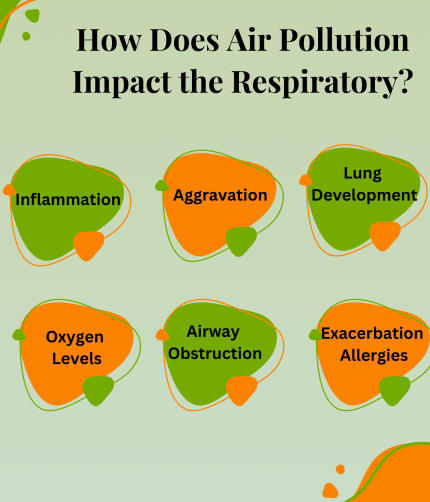
- Inflammation
The immune system reacts to pollutants like PM2.5, ozone, and NO₂ by releasing inflammatory molecules like cytokines, which can harm the sensitive tissues in the airways. Coughing, wheezing, and shortness of breath are indications of inflammation-induced swelling, which narrows and irritates the airways.
The respiratory system creates extra mucus in reaction to pollution to capture and eliminate the dangerous particles. Congestion and post-nasal drip, in which mucus runs down the back of the throat, result from this. This can irritate the throat, induce coughing, and make breathing difficult.
- Aggravation
Air pollution exposure can increase the frequency and intensity of asthma episodes in those who have the condition. Breathing becomes more difficult as a result of bronchoconstriction brought on by these pollutants irritating the airways. Symptoms including wheezing, chest tightness, and trouble exhaling may arise from this.
COPD risk is increased by prolonged exposure to pollutants, particularly particulate matter. COPD is a collection of lung conditions that cause airflow restriction and progressive lung deterioration, such as emphysema and chronic bronchitis.
The deterioration of lung function is accelerated by air pollution, which makes breathing more difficult for those with COPD and raises their risk of complications, including respiratory infections.
- Lung Development
They may become more vulnerable to respiratory infections and diseases like asthma as a result of this decreased lung function. An increased chance of acquiring chronic respiratory disorders later in life is one of the long-term health issues that might occasionally result from early exposure to air pollution.
Chronic exposure to air pollution can cause lung function and capacity to decline in both adults and children. Shortness of breath, weariness, and a decreased capacity for exertion might arise from the lungs’ decreased ability to carry oxygen to the circulation.
- Oxygen Levels
Pollutants like PM2.5 and NO₂ can damage the immune cells in the respiratory system, reducing their ability to fight off infections. This makes it easier for pathogens to enter the lungs and cause infections like bronchitis, pneumonia, and the flu.
These infections can worsen pre-existing conditions like asthma and COPD, leading to more frequent hospital visits and longer recovery times.
- Airway Obstruction
This can make it harder to breathe, especially for individuals with asthma or other lung diseases.
Bronchoconstriction results in wheezing and shortness of breath, both of which are common symptoms of asthma exacerbated by air pollution. In severe cases, it can lead to asthma attacks, requiring emergency medical treatment.
- Exacerbation Allergies
Because air pollution increases the respiratory system’s sensitivity to allergens like dust, mould, and pollen, it can also make allergic reactions more severe.
Ozone and PM2.5 pollutants can increase the sensitivity of the airways and nasal passages to allergens, resulting in symptoms including wheezing, runny nose, itchy eyes, and sneezing. This can make flare-ups more frequent and make managing asthma or allergic rhinitis more difficult for those who have it.
How Air Pollution Affects Your Breathing
The consequences of air pollution on breathing can be both immediate and long-term. Tell us about the immediate results.
When you are exposed to pollution, you may get irritated lungs. Exposure to air pollutants can cause swelling in the airways of your respiratory system.
As a result of air pollution irritating your lungs and airways, you may cough all the time. Your lungs get irritated by the air pollutants, making breathing difficult.
A common complaint is that they sneeze all the time. You have an infection in your respiratory tract. You should breathe clean air to prevent illnesses in your respiratory tract.
The intake of air pollutants is what triggers asthma attacks. Continuous exposure to air pollutants tends to exacerbate your asthma symptoms.
Continued exposure to air pollution reduces lung function. Consequently, breathing becomes more challenging.
- Long-Term Effects
Lung cancer is becoming more common these days, according to several studies. When you breathe, air contaminants can enter your lungs. A person gets lung cancer if these air pollutants stay in their lungs for an extended period.
Nowadays, a lot of people have COPD. Once more, it results from extended exposure to air contaminants, which is what causes COPD.
The lungs will progressively stop working when they come into contact with air pollutants. Consequently, you have respiratory problems.
A lot of people are unaware that they may have cardiac problems. When air pollutants are continuously present, this can occur.
You are inviting your demise if you already have respiratory issues.
The medication Deslor 5 can be used to treat respiratory issues.
Which Individuals Are More At Risk From Air Pollution?
According to study results, a significant portion of children suffer from asthma. The continuous inhalation of airborne pollutants can sometimes also have an impact on the respiratory system.
It has been shown that children are more likely than adults to suffer from asthma and COPD.
Older adults are more likely than youngsters to suffer from lung-related conditions. Elderly people’s respiratory systems and lungs begin to malfunction as a result of breathing in toxins. Because of this, they endure months of chronic lung illness.
Women who are about to become pregnant are more vulnerable to lung problems. Use Hisone 5 to keep lung allergies at bay.
There is no question from a scientific perspective that the air in our cities is unhealthy; thus, it is critical to make the logical transition from scientific data to legislative action.
A Medypharmacy must be consulted to properly manage their problems, which include taking the right drugs and scheduling routine examinations.







